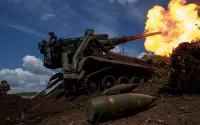30 October 2007Amit R. Paley
The largest dam in Iraq is in serious danger of an imminent collapse that could unleash a trillion-gallon wave of water, possibly killing thousands of people and flooding two of the largest cities in the country, according to new assessments by the U.S. Army Corps of Engineers and other U.S. officials.
Even in a country gripped by daily bloodshed, the possibility of a catastrophic failure of the Mosul Dam has alarmed American officials, who have concluded that it could lead to as many as 500,000 civilian deaths by drowning Mosul under 65 feet of water and parts of Baghdad under 15 feet, said Abdulkhalik Thanoon Ayoub, the dam manager. "The Mosul dam is judged to have an unacceptable annual failure probability," in the dry wording of an Army Corps of Engineers draft report.
At the same time, a U.S. reconstruction project to help shore up the dam in northern Iraq has been marred by incompetence and mismanagement, according to Iraqi officials and a report by a U.S. oversight agency to be released Tuesday. The reconstruction project, worth at least $27 million, was not intended to be a permanent solution to the dam's deficiencies.
"In terms of internal erosion potential of the foundation, Mosul Dam is the most dangerous dam in the world," the Army Corps concluded in September 2006, according to the report to be released Tuesday. "If a small problem [at] Mosul Dam occurs, failure is likely."
The effort to prevent a failure of the dam has been complicated by behind-the-scenes wrangling between Iraqi and U.S. officials over the severity of the problem and how much money should be allocated to fix it. The Army Corps has recommended building a second dam downstream as a fail-safe measure, but Iraqi officials have rejected the proposal, arguing that it is unnecessary and too expensive.
The debate has taken place largely out of public view because both Iraqi and U.S. Embassy officials have refused to discuss the details of safety studies -- commissioned by the U.S. government for at least $6 million -- so as not to frighten Iraqi citizens. Portions of the draft report were read to The Washington Post by an Army Corps official who spoke on condition of anonymity because of the sensitivity of the matter. The Post also reviewed an Army Corps PowerPoint presentation on the dam.
"The Army Corps of Engineers determined that the dam presented unacceptable risks," U.S. Ambassador Ryan C. Crocker and Gen. David H. Petraeus, the U.S. commander in Iraq, wrote in a May 3 letter to Prime Minister Nouri al-Maliki. "Assuming a worst-case scenario, an instantaneous failure of Mosul Dam filled to its maximum operating level could result in a flood wave 20 meters deep at the City of Mosul, which would result in a significant loss of life and property."
Sitting in a picturesque valley 45 miles along the Tigris River north of Mosul, the earthen dam has one fundamental problem: It was built on top of gypsum, which dissolves when it comes into contact with water.
Almost immediately after the dam was completed in the early 1980s, engineers began injecting the dam with grout, a liquefied mixture of cement and other additives. More than 50,000 tons of material have been pumped into the dam since then in a continual effort to prevent the structure, which can hold up to 3 trillion gallons of water, from collapsing.
After the U.S.-led invasion of Iraq in 2003, American officials began to study risks posed by the dam, which they said were underestimated by Iraqis.
"Iraqi government believes dam is safe," concluded a 32-page PowerPoint presentation prepared by the Army Corps and dated December 2006.
On a tour of the dam on a recent blistering afternoon, Ayoub, the manager, contended that the dam was safe but acknowledged the unusual problems with it.
Seepage from the dam funnels into a gushing stream of water that engineers monitor to determine the severity of the leakage. Twenty-four clanging machines churn 24 hours a day to pump grout deep into the dam's base. And sinkholes form periodically as the gypsum dissolves beneath the structure.
"You cannot find any other dam in the world like this," said Ayoub, a mustachioed man in a dark business suit who has worked at the dam since 1983 and has managed it since 1989.
About two years ago, Ayoub became concerned that the pressure of the water was putting the dam at risk of failure. So he ordered that the dam's water level, which can reach 330 meters above sea level, not exceed 319 meters.
But reports prepared by the Army Corps of Engineers began to raise new alarms.
"Mosul Dam is 'unsafe' in any definition," the PowerPoint presentation said. It added: "Condition continually degrading" and "Failure mode is credible." Under a section labeled "Consequences of Failure," it says: "Mass civilian fatalities."
Ayoub said U.S. officials spoke in person about the dam in even more apocalyptic terms. "They went to the Ministry of Water Resources and told them that the dam could collapse any day," he said.
The report so alarmed the governor of Nineveh province, where the dam is located, that he asked that it be drained of all water immediately, Ayoub said.
Ayoub said he agrees that the most catastrophic collapse of the dam could kill 500,000 people, but he said U.S. officials have not convinced him that the structure is at high risk of collapse. "The Americans may very well be right about the danger," Ayoub said. "I think it is safe enough that my office is in the flood plain."
In an interview Monday night, Abdul Latif Rashid, Iraq's minister of water resources, said that he believed the safety situation was not critical and that he was more inclined to trust his engineers than American reports.
"Is the dam going to collapse tomorrow?" Rashid said. "I can't tell you that. Let us hope that we avoid a disaster and focus now on a solution."
The Army Corps has recommended that a partially constructed dam at Badush, which lies between Mosul Dam and the city, be finished as a stopgap measure in case Mosul Dam collapses.
But Salar Bakir Sami, director general of planning and development at the Water Resources Ministry, said Iraqi government officials do not think it is necessary to spend the estimated $10 billion for such a project. Instead, he said, the ministry planned to spend $300 million to construct a smaller version of the Badush dam that would generate electricity and provide irrigation, but not serve as a safety valve in case Mosul Dam breaks.
Rashid said his top priority is to fix Mosul Dam by building a concrete wall at its foundation that should shore up the design and provide "a permanent solution." He said experts have just discovered cutting-edge technology that would allow such a wall to be built, perhaps with construction starting by next year at a cost of less than $1 billion.
In the report to be released Tuesday, the Office of the Special Inspector General for Iraq Reconstruction, a federal oversight agency, found that little of the reconstruction effort led by the U.S. Embassy has succeeded in improving the dam. The office reviewed contracts worth $27 million, but an embassy official said the total cost of the project was $34 million.
The review found that a Turkish company, which was paid $635,000 for a contract awarded 19 months ago to build storage silos for cement, had done so little and such poor-quality work that its project may have to be restarted. One company contracted to design grout-mixing plants instead submitted plans for unusable concrete-mixing plants. High-tech equipment meant to help grouting is gathering dust because it won't work, according to investigators.
Embassy and Army Corps officials noted that it has been difficult to conduct oversight of the project because it is in a dangerous area. They said that contracts with the worst businesses have been terminated and that steps have been taken to ensure better management of the project in the future.
"Our focus is on whether the project that the Corps undertook got carried out and the answer to that question is no," said Stuart W. Bowen Jr., the special inspector general. "The expenditures of the money have yielded no benefit yet."
http://www.washingtonpost.com/wp-dyn/content/article/2007/10/29/AR2007102902193.html?sub=AR






